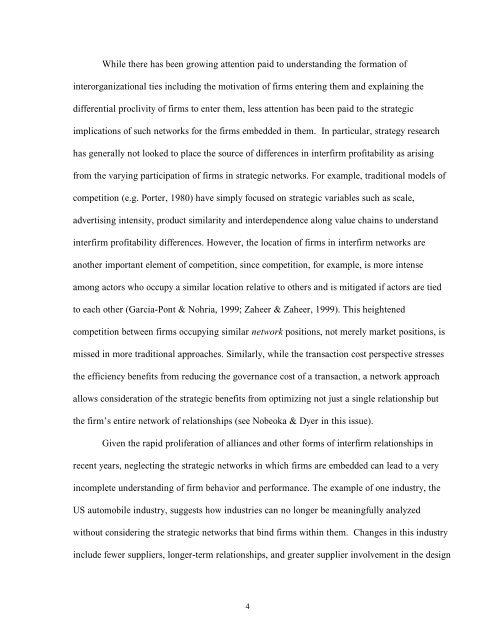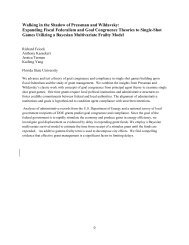STRATEGIC NETWORKS Ranjay Gulati, Nitin Nohria, Akbar Zaheer ...
STRATEGIC NETWORKS Ranjay Gulati, Nitin Nohria, Akbar Zaheer ...
STRATEGIC NETWORKS Ranjay Gulati, Nitin Nohria, Akbar Zaheer ...
Create successful ePaper yourself
Turn your PDF publications into a flip-book with our unique Google optimized e-Paper software.
While there has been growing attention paid to understanding the formation ofinterorganizational ties including the motivation of firms entering them and explaining thedifferential proclivity of firms to enter them, less attention has been paid to the strategicimplications of such networks for the firms embedded in them. In particular, strategy researchhas generally not looked to place the source of differences in interfirm profitability as arisingfrom the varying participation of firms in strategic networks. For example, traditional models ofcompetition (e.g. Porter, 1980) have simply focused on strategic variables such as scale,advertising intensity, product similarity and interdependence along value chains to understandinterfirm profitability differences. However, the location of firms in interfirm networks areanother important element of competition, since competition, for example, is more intenseamong actors who occupy a similar location relative to others and is mitigated if actors are tiedto each other (Garcia-Pont & <strong>Nohria</strong>, 1999; <strong>Zaheer</strong> & <strong>Zaheer</strong>, 1999). This heightenedcompetition between firms occupying similar network positions, not merely market positions, ismissed in more traditional approaches. Similarly, while the transaction cost perspective stressesthe efficiency benefits from reducing the governance cost of a transaction, a network approachallows consideration of the strategic benefits from optimizing not just a single relationship butthe firm’s entire network of relationships (see Nobeoka & Dyer in this issue).Given the rapid proliferation of alliances and other forms of interfirm relationships inrecent years, neglecting the strategic networks in which firms are embedded can lead to a veryincomplete understanding of firm behavior and performance. The example of one industry, theUS automobile industry, suggests how industries can no longer be meaningfully analyzedwithout considering the strategic networks that bind firms within them. Changes in this industryinclude fewer suppliers, longer-term relationships, and greater supplier involvement in the design4




